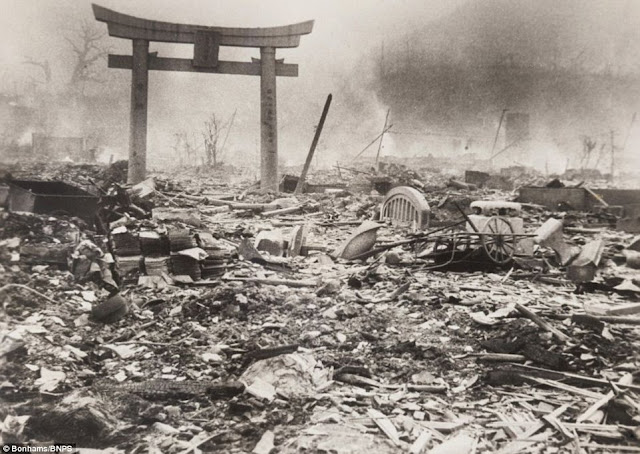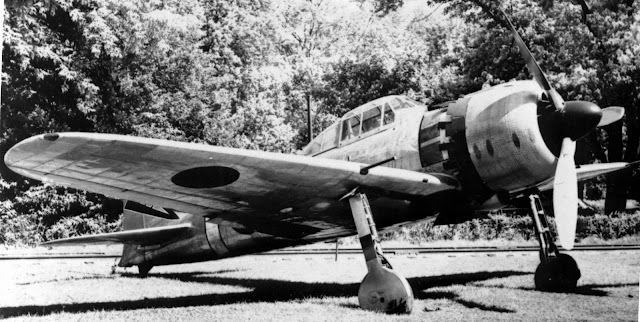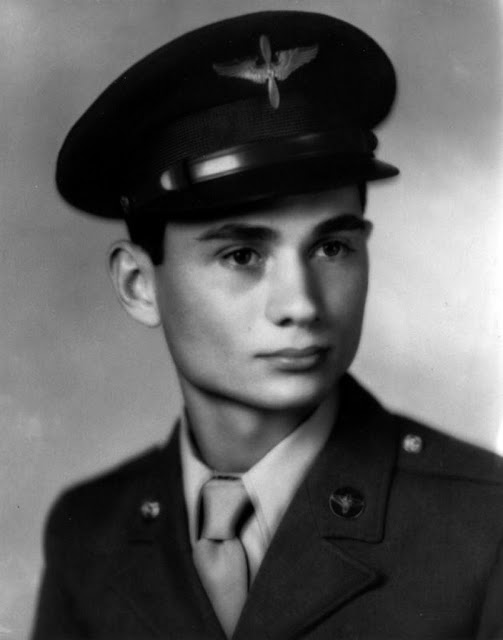The Final Gravestone
 |
| Calverton National Cemetery in New York, the largest cemetery in the National Cemetery Administration. |
Firsts and lasts are always interesting because they provide some insight into underlying realities. The first person killed during World War II (strictly defined as beginning with the German invasion of Poland) was a Pole, 43-year-old Catholic farmer Franciszek Honiok. Honiok wasn't a soldier, he just happened to be in the wrong place at the wrong time. Honiok's murder by the SS was used as a pretext for the German invasion of Poland as part of the
Gleiwitz Operation. Circling around to the end of the conflict, the last American killed illustrates how conflicts, just as they begin erratically and thereby take some random life, don't end with mathematical precision, either. Instead, such incidents have a tempo of their own and provide a window into those times that otherwise is obscured. So, let's peek through the window, just for a moment.
 |
| B-29s over Japan, 1945. The most devastating raid of the war on Tokyo was 9 March 1945 (Operation Meetinghouse), when 330 B-29s dropped incendiaries that resulted in an estimated 100,000 deaths. |
First, let's define the end of World War II. The Allies had been closing in on Japan proper throughout 1945. Despite the increasing futility of Japanese resistance and the surrender of ally Germany in May, the Japanese High Command refused to surrender. Among many other reasons, there was a strong body of opinion that surrender was unthinkable because it would expose the Emperor to personal danger. Emperor Hirohito himself always had the final say, but he was, for lack of a better term, intimidated by his generals and needed special motivation to overrule them. Something special had to be done to break this resistance to surrender. The Allies had the answer - actually, several answers.
 |
| B-29 "Enola Gay" (4-86292), named by pilot Paul Tibbets for his mother. |
At 08:15 a.m. local time 6 August 1945, USAAF B-29 Enola Gay dropped an atomic bomb on the city of Hiroshima pursuant to Special Mission 13, authorized by Operations Order No. 35. Casualties were immense, in the tens of thousands, and the city was devastated. President Truman demanded an unconditional surrender, warning Japan that it could anticipate "expect a rain of ruin from the air, the like of which has never been seen on this earth." This, however, was insufficient to force a Japanese surrender. So, it was back to the drawing board.
 |
| Soviet troops on the bank of the Songhua River in Harbin, 20 August 1945 (Yevgeny Khaldei). |
Next, on 8 August 1945, the Soviet Union declared war on Japan. The Soviets had had their eyes on the Japanese territory in Manchukuo since before Hitler even invaded Poland, and now they had a golden opportunity to acquire it. The invasion (the Manchurian Strategic Offensive Operation) began in the early morning hours of 8 August 1945 and encountered sporadic resistance. This too, however, was insufficient to force a Japanese surrender. In fact, the invasion only instigated a decision to impose martial law in Japan.
 |
| Nagasaki after the atom bomb attack(Yosuke Yamahata). |
Later in the day on 9 August 1945, the USAAF sent another B-29, Bockscar, to bomb the Japanese city of Nagasaki as part of Special Mission 16. Bockscar, under the command of Major Charles W. Sweeney, dropped atomic bomb Fat Man. Once again, casualties were horrendous with tens of thousands perishing, and the bomb flattened the city. The Japanese had not even defended the city, assuming that the small formation of bombers was there simply for reconnaissance. Of course, they were wrong... but they remembered their mistake.
 |
| Nagasaki after the atom bomb attack (Yosuke Yamahata). |
The Japanese still refused to surrender, but many in the Imperial Army now were having second thoughts. A period of bad weather then settled over Japan, which made further attacks difficult. The USAAF did have another atomic bomb ready for delivery in about a week's time, but there was going to be a delay regardless of what the Japanese or anyone else decided to do. The first two atomic bombs, though, along with the Soviet invasion, had set events in motion within Japan sufficiently to make further atomic attacks unnecessary.
 |
| A B-29 of the of the 315th Bomb Wing takes off on 26 June 1945 for the unit's first mission over Japan. |
The USAAF kept up the pressure by other means, however. On 14 August 1945, B-29s of the 315 Bombardment Wing attacked the Nippon Oil Company refinery at Tsuchizaki on the northern tip of Honshū. It was the last operational oil refinery in Japan, and after this destruction, Japan had no viable sources of oil. The raid was vicious, and for various technical reasons turned into the longest bombing mission of the war. In addition, the US Third Fleet began shelling the Japanese coast.
 |
| Emperor Hirohito (AP Photo). |
After much deliberation, and some abortive attempts at sabotage by members of the Japanese Imperial Army, the Japanese Emperor, Hirohito, surrendered. He gave a four-minute radio address at 12:00 noon on 15 August 1945. It was the first time he had allowed his voice to be heard by the nation and came to be called the Jewel Voice Broadcast. In it, Hirohito announced the surrender of Japan. Technically, this should have ended all Japanese military action. However, resistance within the Japanese Imperial Army remained strong despite the Emperor's command, and a few scattered incidents occurred which led to the final American death of World War II.
 |
| Australian Sergeant Leonard G. Siffleet of M Special Unit about to be beheaded by Japanese officer Yasuno Chikao, Aitape, New Guinea, 24 Oct 1943. |
North of Nagasaki, some Japanese soldiers pulled 16 American POWs out of their prison and killed them with swords. This was an anomaly - many US prisoners (such as Pappy Boyington) recalled their captors becoming friendly once the surrender was announced. However, for all intents and purposes, the Allies figured that the war was over and, thus, so was Japanese resistance. They figured wrong.
 |
| Soviet troops on a T-34-85 invading Manchuria. |
The USAAF had encountered little opposition over Japan in the final weeks of the war and operated with virtual impunity. The Japanese hadn't even bothered to intercept many small USAAF missions over Japan apparently intended solely for reconnaissance. Now, with the surrender in hand, there was even less reason to think that reconnaissance flights would encounter any problems. However, now two such small missions - the bombings of Hiroshima and Nagasaki - had produced devastating consequences, and the Japanese had no desire to suffer a third. The Allies had not yet set foot on Japanese soil, and the Soviets continued to batter away in Manchuria, so the Japanese military remained on a war footing. The stage was set for one, last tragic confrontation.
 |
| A B-32 of the 386th Bombardment Squadron with its crew at Yontan, Okinawa (US Air Force). |
On 18 August 1945, the 386th Bombardment Squadron based on Yontan, Okinawa sent two Consolidated B-32 Dominator bombers on a standard photo mission over Japan. Even before the Japanese surrender, this should have been a mission with minimal risk. On one of those two aircraft, 42-1085768, was U.S. Army photographer Sgt. Anthony J. Marchione of the 20th Reconnaissance Squadron.
 |
| A B-32 of the 386th Bombardment Squadron at Yontan, Okinawa (US Air Force). |
The two Dominators - a little-remembered plane, but essentially a backup/substitute for the B-29 - flew over Tokyo, the crews expecting little trouble. The Japanese military, though, was waiting. The Japanese apparently figured that Tokyo was an inviting target for the next atomic bomb (it wasn't, but they could not know that), and the small force of USAAF bombers was reminiscent of the two previous attacks. While the Japanese economy was in shambles and the military absolutely defeated, the Japanese still had very capable soldiers and equipment when the need arose. The Japanese began to defend their city.
First, Japanese anti-aircraft batteries opened fire. However, the Japanese flak was targeted poorly and did not interfere with the mission, but it was a bad omen that things were not quite right. The crew of the B-32s attempted to communicate with the Japanese by radio to tell them to stop shooting but received no reply.
 |
| A Ki-44 Shoki. It was a standard interceptor from 1942-45. |
Second, Japanese fighters took off and intercepted the two Dominators. It is uncertain what planes were used, but they apparently were Nakajima Ki-44 Shoki ("Tojos") army fighters, Mitsubishi A6M5 Zero ("Zekes") naval fighters, and/or Kawanishi N1K2 Shiden ("George") fighters. All were perfectly capable late-war aircraft flown by veteran pilots. Tokyo would have had the best fighter defenses remaining to the Japanese due to the threat posed by American bombs to the life of the Emperor.
 |
| Saburo Sakai. |
What happened next is unclear, and the narrative depends on varying accounts of the participants, but the end result is the same in all accounts. Japanese naval ace Lt. Saburo Sakai (64 victories) later wrote that he was part of this mission, though he claimed that he, personally, never fired a shot. At first, he mistook the planes for B-29, but then realized they were B-32s. The co-pilot of one of the Dominators, 1st Lt. Richard E. Thomas,, later recalled that the Japanese fighters came in as if the war was still on. Despite Thomas' evasive action (pilot 1st Lt. J.R. Anderson was not in the cockpit for some reason), the fighters hit the B-32 in the wings and fuselage.
 |
| Mitsubishi A6M5 Model 52 Zero-Sen (Navy Type 0 Carrier Fighter) (USAAF Photos 1-5, Edgar Diegan Photo 6). |
Things then got nasty. Despite being full of holes, the B-32 was still airworthy but slowed. Staff Sgt. Joseph Lacherite was handling radio communications in the damaged bomber. He later recalled that one of the Japanese pilots spoke to him in English:
Yes, please slow down so I can shoot you down, too.
Lacherite later claimed that the voice was that of Sakai, who was fluent in English (though of course, Lacherite had no idea at the time who was speaking to him).
 |
| The Kawanishi N1K-J Shiden ("Violet Lightning"). |
The Japanese fighters resumed their attack, making more strikes on the slowed B-32. Lacherite was wounded (it would take him five years to recover). Sergeant Marchione came to Lacherite's aid, but more cannon shells raked the bomber. Shrapnel hit Marchione, and he too was badly wounded. Thomas and Anderson then managed to evade the fighters and make it back to Okinawa.
 |
| Sgt. Anthony J. Marchione (Robert F. Door Collection). |
Though badly wounded, Joe Lacherite survived. Marchione, however, did not respond to treatment. He succumbed before the bomber landed back at base. Marchione was only 19, still a month shy of his 20th birthday. Who was Marchione? Just an ordinary kid from Pottstown, Pa. Played the trumpet, liked photography once he got in the army - a kid like millions of other kids. Saburo Sakai lived until 2000 and disclaimed any responsibility for the fatality. He said that he was never questioned about the incident - apparently, nobody was.
Strangely enough, the last victim was a photographer. In any event, regardless of cause or killer, Tony Marchione was the last American killed in World War II. RIP.
2020


















No comments:
Post a Comment